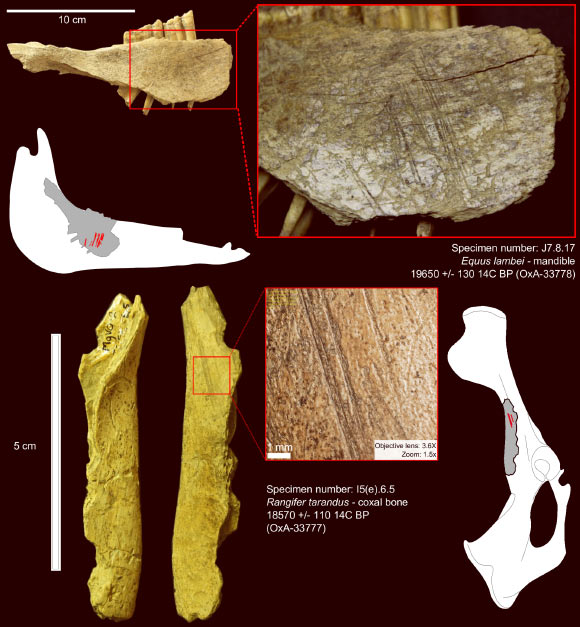Humans first arrived in North America 10,000 years earlier than previously thought, according to an analysis of ancient animal bones found in northern Yukon, Canada.

Top: cut marks on a horse mandible from Bluefish Cave II; the specimen is dated to 19,650 years before present; the bone surface is a bit weathered and altered by root etching but the cut marks are well preserved; they are located on the medial side, under the third and second molars, and are associated with the removal of the tongue using a stone tool. Bottom: cut marks on a caribou coxal bone from Bluefish Cave II; the specimen is dated to 18,570 years before present and shows straight and parallel marks resulting from filleting activity. Image credit: L. Bourgeon et al, doi: 10.1371/journal.pone.0169486.
“The earliest settlement date of North America, until now estimated at 14,000 years before present, is now estimated at 24,000 years before present,” said lead author Lauriane Bourgeon, a doctoral student in the Department of Anthropology at the University of Montreal, and co-authors.
They made their discovery using artifacts from the Bluefish Caves, located on the banks of the Bluefish River in northern Yukon.
Excavated from 1977 to 1987 under the direction of Archaeological Survey of Canada researcher Dr. Jacques Cinq-Mars, the site occupies a unique place in Eastern Beringian prehistory.
Based on radiocarbon dating of animal bones, Dr. Cinq-Mars made the bold hypothesis that human settlement in the region dated as far back as 30,000 years before present.
In the absence of other sites of similar age, Dr. Cinq-Mars’ hypothesis remained highly controversial in the scientific community.
“Bluefish Caves is the oldest known archaeological site in North America. Our results demonstrate that humans occupied Bluefish Caves as early as 24,000 years before present,” Bourgeon and co-authors said.
The team examined 36,000 mammal bone fragments culled from the site. Comprehensive analysis of certain pieces revealed undeniable traces of human activity in 15 bones. Around 20 other fragments also showed probable traces of the same type of activity.
“Series of straight, V-shaped lines on the surface of the bones were made by stone tools used to skin animals. These are indisputable cut-marks created by humans,” said University of Montreal Professor Ariane Burke, co-author on the study.
The researchers submitted the bones to further radiocarbon dating.
The oldest fragment, a horse mandible showing the marks of a stone tool apparently used to remove the tongue, was radiocarbon-dated at 19,650 years, which is equivalent to between 23,000 and 24,000 calibrated years before present.
“Our discovery confirms previous analyses and demonstrates that this is the earliest known site of human settlement in Canada. It shows that Eastern Beringia was inhabited during the last Ice Age,” Prof. Burke said.
“Beringia is a vast region stretching from the Mackenzie River in the Northwest Territories to the Lena River in Siberia.”
“Studies in population genetics have shown that a group of a few thousand individuals lived in isolation from the rest of the world in Beringia 15,000 to 24,000 years ago,” she said.
“Our results offer archaeological support for the Beringian Standstill hypothesis.”
“Genetic isolation would have corresponded to geographical isolation. During the Last Glacial Maximum, Beringia was isolated from the rest of North America by glaciers and steppes too inhospitable for human occupation to the West. It was potentially a place of refuge.”
“The Beringians of Bluefish Caves were therefore among the ancestors of people who, at the end of the last Ice Age, colonized the entire continent along the coast to South America.”
The findings were published Jan. 6, 2017 in the journal PLoS ONE.
_____
L. Bourgeon et al. 2017. Earliest Human Presence in North America Dated to the Last Glacial Maximum: New Radiocarbon Dates from Bluefish Caves, Canada. PLoS ONE 12 (1): e0169486; doi: 10.1371/journal.pone.0169486







